Разглеждане на Шанхай
Посетете забележителностите на Шанхай и се потопете в китайската култура
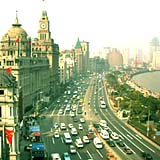 Бунд, което означава насипът, се отнася до известната брегова ивица на Шанхай, минаваща по западния бряг на река Хуангпу, образувайки източната граница на стария център на Шанхай. През последните години много от тези сгради бяха възстановени до предишната им слава и превърнати в луксозни магазини, ресторанти и офиси. Бунд, което означава насипът, се отнася до известната брегова ивица на Шанхай, минаваща по западния бряг на река Хуангпу, образувайки източната граница на стария център на Шанхай. През последните години много от тези сгради бяха възстановени до предишната им слава и превърнати в луксозни магазини, ресторанти и офиси.
Акцентът на Bund несъмнено са сградите от колониалната епоха, облицоващи западната страна на Zhongshan Dong Yi Lu, сред които се открояват бившето британско консулство, митницата, бившата банка на Хонконг и Шанхай и хотел Peace.
Северният край на Бунд започва от сливането на Huangpu и Suhou Creek от моста Waibaidu. Мостът е построен през 1906 г., за да замени оригиналния дървен платен мост, построен през 1856 г. от английски бизнесмен.
На брега на реката сега се издига гранитен обелиск Паметник на народните герои. Паметникът е посветен на китайските патриоти от Комунистическата партия през 1840-те години. Построен е през 1993 г. и съдържа малка историческа галерия в основата си, Историческия музей на Бунд. Точно на юг от паметника, на нивото на улицата, е паркът Huangpu Gongyuan.
Южно от Bund, срещу хотел Peace, е входът на тунела за разглеждане на забележителности Bund. Разположен под Huangpu и пълен с трамвайни вагони и светлинни шоута, този тунел свързва центъра на Шанхай с новия район Pudong и телевизионната кула Oriental Pearl. Тук е и първата бронзова статуя на Чен И в Шанхай.
| Храмът на Нефритения Буда |
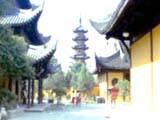 Jade Buddha Temple is one of the most famous Buddhist temples
to be found in Shanghai. The Jade Buddha Temple was built in
1882 by a monk named Hui Gen who brought back two jade Buddhist
statues from Burma. In the temple, there are several grandiose
halls which house one 1.9 meter high white jade sitting statue
of Sakyamuni (the founder of Buddhism), one 96 centimeter long
sleeping jade Buddha and several sleeping jade statues and bronze
statues respectively. Many people come to worship each day and
burn incense at this very holy and active shrine. No photography
of the Jade Buddha is permitted, but postcards are available
and photography is allowed in other rooms. Jade Buddha Temple is one of the most famous Buddhist temples
to be found in Shanghai. The Jade Buddha Temple was built in
1882 by a monk named Hui Gen who brought back two jade Buddhist
statues from Burma. In the temple, there are several grandiose
halls which house one 1.9 meter high white jade sitting statue
of Sakyamuni (the founder of Buddhism), one 96 centimeter long
sleeping jade Buddha and several sleeping jade statues and bronze
statues respectively. Many people come to worship each day and
burn incense at this very holy and active shrine. No photography
of the Jade Buddha is permitted, but postcards are available
and photography is allowed in other rooms.
Address: 170 Anyuan Lu, Putuo, Northwest Shanghai
Tel: (8621) 6266-3668
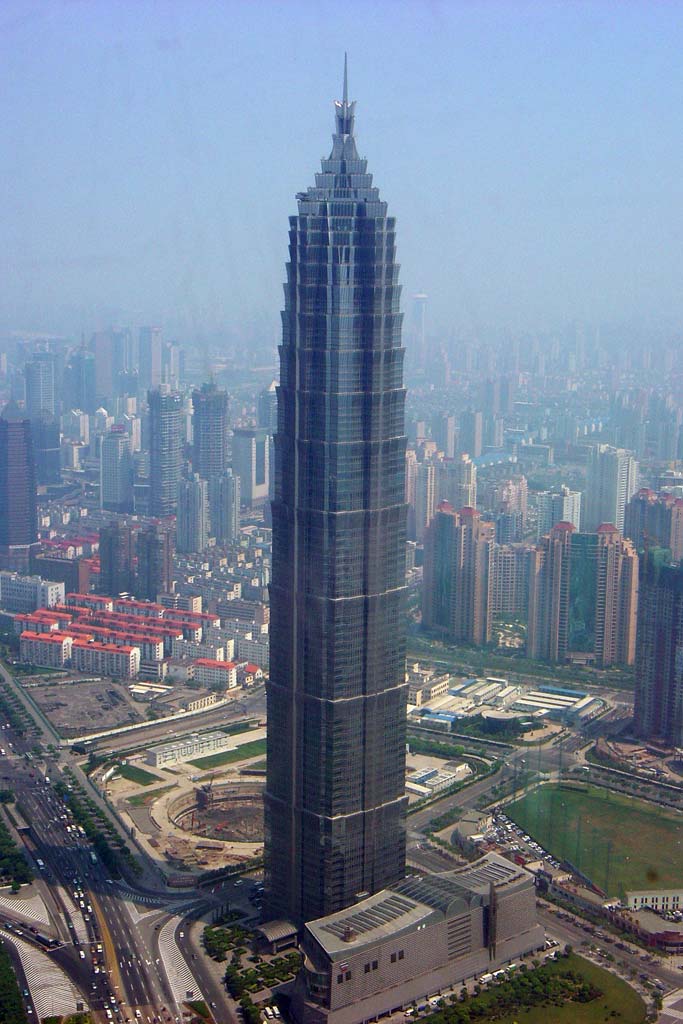 Standing at the center of Lujiazui Finance and Trade Zone, the
Jin Mao Tower is one of the highest buildings in the world with
88 stories, standing at 420.5 meters high with total floor space
of 290,000 square meters. Built in 1998 as a Sino-American joint
venture, this building has a blending of traditional Chinese
and modern Western tower designs. The building consists of 13
distinct tapering segments, with high-tech steel bands binding
the glass like an exoskeleton. Offices occupy the first 50 floors,
the Grand Hyatt hotel the 51st to the 88th floors, while a public
observation deck on the 88th floor ("The Skywalk")
offers views to rival those of the nearby Oriental Pearl TV Tower.
High-speed elevators (9m or 31ft. per sec.) whisk visitors from
Level B1 to the top in less than 45 seconds. The view from there
is almost too high, but exquisite on a clear day. You can also
look down at the 152 meter high (517ft.) atrium of the Grand
Hyatt. Standing at the center of Lujiazui Finance and Trade Zone, the
Jin Mao Tower is one of the highest buildings in the world with
88 stories, standing at 420.5 meters high with total floor space
of 290,000 square meters. Built in 1998 as a Sino-American joint
venture, this building has a blending of traditional Chinese
and modern Western tower designs. The building consists of 13
distinct tapering segments, with high-tech steel bands binding
the glass like an exoskeleton. Offices occupy the first 50 floors,
the Grand Hyatt hotel the 51st to the 88th floors, while a public
observation deck on the 88th floor ("The Skywalk")
offers views to rival those of the nearby Oriental Pearl TV Tower.
High-speed elevators (9m or 31ft. per sec.) whisk visitors from
Level B1 to the top in less than 45 seconds. The view from there
is almost too high, but exquisite on a clear day. You can also
look down at the 152 meter high (517ft.) atrium of the Grand
Hyatt.
Address: 2 Shiji Da Dao, (3 blocks southeast of Oriental Pearl
TV Tower), Pudong, Shanghai
Tel: (8621) 5047-5101
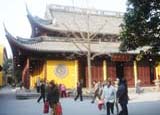 Longhua
Temple is the oldest and largest Buddhist architecture in Shanghai
area. It was built during the Five Dynasties (907-960 AD). An
octagonal, 40 meter high pagoda was built in the Song Dynasty
in the temple. It houses many Buddhist scriptures, gold seals
and statues from the Tang Dynasty, the Five Dynasties, the Ming
Dynasty and the Qing Dynasty. Longhua Temple has been destroyed
several times in history and today's temple was rebuilt during
the Daoguang Reign of the Qing Dynasty. Longhua
Temple is the oldest and largest Buddhist architecture in Shanghai
area. It was built during the Five Dynasties (907-960 AD). An
octagonal, 40 meter high pagoda was built in the Song Dynasty
in the temple. It houses many Buddhist scriptures, gold seals
and statues from the Tang Dynasty, the Five Dynasties, the Ming
Dynasty and the Qing Dynasty. Longhua Temple has been destroyed
several times in history and today's temple was rebuilt during
the Daoguang Reign of the Qing Dynasty.
The extensive temple grounds have an area of over 20,000 square
meters. The north side of the newly created pedestrian street
is often crowded with incense-bearing supplicants. There are
four main halls, the most impressive of which is the third hall,
or Daxiong Bao Dian (Grand Hall). In this hall, a gilded statue
of Sakyamuni sits under a beautifully carved dome, flanked on
each side by 18 arhats (disciples). At the back of the hall,
Guanyin, the Goddess of Mercy, presides over a fascinating tableau
representing the process of reincarnation: a boat in the bottom
right corner indicates birth, while death waits at the bottom
left corner. The fourth hall, Sanshen Bao Dian, features three
incarnations of the Buddha. Behind the third and fourth halls
is a basic, but popular vegetarian restaurant.
Longhua is also famous for its midnight bell-ringing every New
Year's Eve (Dec 31-Jan 1), which takes place in the three-storied
Zhong Lou (Bell Tower) near the entrance. The tower's 3,000-kilogram
(3.3 ton) bronze bell, cast in 1894, is struck 108 times to dispel
all the worries said to be afflicting mankind.
Address: 2853 Longhua Lu, Shanghai
Tel: (8621) 6456-6085
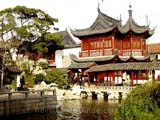 Yu Yuan is located at the heart of Old Town, Nanshi, a few blocks
southwest of the Bund in downtown Shanghai. Yu Yuan, meaning
Garden of Peace and Comfort, was built in the Ming Dynasty by
a high official in the imperial court in honor of his father.
In 1760, some rich merchants bought Yuyuan Garden and spent more
than 20 years reconstructing the buildings. During the Opium
War of the 19th century, Yuyuan Garden was severely damaged.
The Yuyuan Garden today is the result of a five-year restoration
project which began in 1956. The garden was open to the public
in September, 1961. Yu Yuan is located at the heart of Old Town, Nanshi, a few blocks
southwest of the Bund in downtown Shanghai. Yu Yuan, meaning
Garden of Peace and Comfort, was built in the Ming Dynasty by
a high official in the imperial court in honor of his father.
In 1760, some rich merchants bought Yuyuan Garden and spent more
than 20 years reconstructing the buildings. During the Opium
War of the 19th century, Yuyuan Garden was severely damaged.
The Yuyuan Garden today is the result of a five-year restoration
project which began in 1956. The garden was open to the public
in September, 1961.
Yuyuan Garden occupies an area of 20,000 square meters which
is about five acres. Its layout features the garden architectural
styles of the southern part of the country during the Ming and
Qing Dynasties. Carved dragons wind across the walls which divide
the garden into five parts with 30 scenic spots. The most outstanding
part is said to be the Great Rockery which is built with about
2,000 tons of rocks. It features perilous peaks, cliffs, winding
caves and gorges. It is claimed to be the most magnificent rockery
of the Ming Dynasty.
Address: At the heart of Old Town Nanshi, few blocks southwest
of the Bund, Shanghai
Tel: (8621) 6355-5032
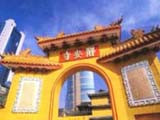 Meaning Palace of Tranquility, the Jin'an Temple contradicts
its name and is always a lively and crowded atmosphere. With
about 17 centuries worth of history, this small, garishly decorated
temple has the longest history of any shrine in Shanghai. Its
chief antiquities are a Ming Dynasty copper bell (the Hongwu
Bell) that weighs in at 3,175 kilograms (3.5 tons) and stone
Buddhas from the Northern and Southern States period (420 AD
589 AD). Before the year 1949, this was Shanghai's richest
Buddhist monastery, presided over by the Abbot, an imposing figure
who kept seven mistresses and a White Russian bodyguard. After
the founding of new China, it was converted to a plastics factory
before its most recent renovation in the year of 1999. Meaning Palace of Tranquility, the Jin'an Temple contradicts
its name and is always a lively and crowded atmosphere. With
about 17 centuries worth of history, this small, garishly decorated
temple has the longest history of any shrine in Shanghai. Its
chief antiquities are a Ming Dynasty copper bell (the Hongwu
Bell) that weighs in at 3,175 kilograms (3.5 tons) and stone
Buddhas from the Northern and Southern States period (420 AD
589 AD). Before the year 1949, this was Shanghai's richest
Buddhist monastery, presided over by the Abbot, an imposing figure
who kept seven mistresses and a White Russian bodyguard. After
the founding of new China, it was converted to a plastics factory
before its most recent renovation in the year of 1999.
Address: 1686 Nanjing Xi Lu, Jing An, Shanghai
Tel: (8621) 6256-6366
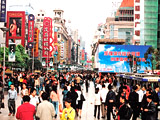 Stretching west from the Bund through the heart of Shanghai,
lies the main commercial streets of the city, one of which is
the premier shopping street, Nanjing Lu, with its two major parallel
arteries, Fuzhou Lu and Yan'an Lu. Stretching west from the Bund through the heart of Shanghai,
lies the main commercial streets of the city, one of which is
the premier shopping street, Nanjing Lu, with its two major parallel
arteries, Fuzhou Lu and Yan'an Lu.
Nanjing Road is one of the most important commercial and tourist
streets in Shanghai. Along this 5.5 kilometer road, you will
find over 600 shops that, on average, are visited by some 1.7
million people each day. It is also a good place to learn the
history and culture of Shanghai. This is essentially Shanghai's
version of the Champs Elysees in Paris or Fifth Avenue in New
York.
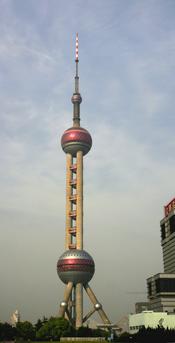 Completed
on Oct. 1, 1994, the Oriental Pearl TV Tower (known in Mandarin
as the Dongfang Mingzhu Guangbo Dianshi Tai) is the modern symbol
of Shanghai City. Standing beside the Huangpu River with a height of 468 meters (1536 feet), it is the
tallest TV tower in Asia and the third highest in the world.
This unusual structure has become one of the favorite spots for
tourists in Shanghai. Completed
on Oct. 1, 1994, the Oriental Pearl TV Tower (known in Mandarin
as the Dongfang Mingzhu Guangbo Dianshi Tai) is the modern symbol
of Shanghai City. Standing beside the Huangpu River with a height of 468 meters (1536 feet), it is the
tallest TV tower in Asia and the third highest in the world.
This unusual structure has become one of the favorite spots for
tourists in Shanghai.
The tower consists of 11 spheres of all different sizes and
arranged at different levels hanging from the sky down to the
green lawns. The body of the tower is formed of two huge glittering
spheres and one small delicate sphere; the sightseeing level
in the upper sphere is 263 meters high, offering a bird's-eye
view of the city. In the upper sphere, 267 meters above ground,
there is a revolving restaurant, a disco ball and a piano accompanied
bar. Even higher up, at 271 meters, there are 20 private Karaoke
rooms. The space cabin is at a level of 350 meters, containing
a sightseeing terrace, a meeting hall and a coffee room. Hotel
in the Air is in the five smaller spheres, and consists of 20
guest rooms. The lower sphere contains a space city. There is
a science fiction city inside the tower pedestal. The Oriental
Pearl TV Tower combines sightseeing, catering, shopping, recreation,
accommodation, broadcasting and TV transmission into one body.
Address: 2 Lujiazui Lu, Pudong, Shanghai
Tel: (8621) 5879-1888
| Sun Yat-Sen Former Residence |
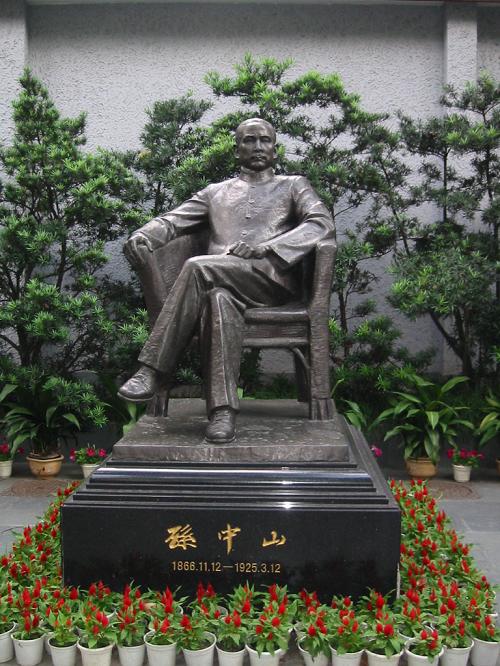 Sun Yat-sen (1866-1925), the great forerunner of the Chinese
democratic revolution, founder of the Republic of China, and
respected contributor to Chinese modern history lived here with
his wife, Soong Ching-ling, from June 1918 to November 1924.
It was here that Dr. Sun accomplished his renowned masterpieces
such as "Doctrines of Sun Wen" and "Plans of China's Development".
It was also here that he received the representatives of the
Communist Party of China and promoted the first cooperation between
the two major parties in Chinese modern history - the Nationalist
Party and the Communist Party. Sun Yat-sen (1866-1925), the great forerunner of the Chinese
democratic revolution, founder of the Republic of China, and
respected contributor to Chinese modern history lived here with
his wife, Soong Ching-ling, from June 1918 to November 1924.
It was here that Dr. Sun accomplished his renowned masterpieces
such as "Doctrines of Sun Wen" and "Plans of China's Development".
It was also here that he received the representatives of the
Communist Party of China and promoted the first cooperation between
the two major parties in Chinese modern history - the Nationalist
Party and the Communist Party.
After his death in 1925, Mrs. Soong continued to live here until
1937 when the Japanese army occupied Shanghai. Eight years later,
upon China winning the war, Mrs. Soong offered to provide her
home as the permanent site to Dr. Sun's memory. In 1961, the
Former Residence of Sun Yat-sen was listed as being one of the
key state preserved by the Cultural Relic Unit.
Today, the former residence of Sun Yat Sen became a tourist
destination. Visitors can enter through the kitchen on the way
to the dining room. Sun's study is upstairs, complete with ink
stone, brushes, maps drawn by Dr. Sun, and a library of 2,700
volumes. The bedroom and the drawing room contain more original
furnishings, including an original "Zhongshan" suit,
similar to the later Mao suit. The backyard has a charming garden.
Address: 7 Xiangshan Lu, west of Fuxing Park at Sinan Lu, Luwan,
Shanghai
Tel.: (8621) 6437-2954 and (8621) 6385-0217
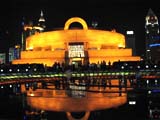 The People's Square, also called "Ren Min Guang Chang", is in
the heart of Shanghai and the south side of the People's Park.
It was once a favorite amusement for the British community and
upper-class Chinese. The People's Square, also called "Ren Min Guang Chang", is in
the heart of Shanghai and the south side of the People's Park.
It was once a favorite amusement for the British community and
upper-class Chinese.
Opened in 1951 and renovated in 1994, with an intermediary spell
as a public reckoning ground during the early days of the Cultural
Revolution (1966-76), the square is now a vast public square
surrounded by government buildings.
Truly an urban park, it features manicured greenery and, at
its heart lies the architecturally impressive Shanghai Museum,
the Grand Theatre, a 20-story Municipal Hall and the Shanghai
Urban Planning Exhibition Hall. Other features include a 320
square meter fountain, central subway station and an underground
shopping mall. Because the square attracts many people, it makes
an ideal venue for people watching and kite flying. Kites are
available at the square for approximately RMB 15.
Address: 231 Nanjing Xi Lu, Huangpu, Shanghai
Tel: (8621) 6372-0626
| Shanghai Xin Tiandi New Heaven and Earth |
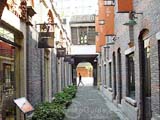 Located in the center of Shanghai City south of Huaihai Zhong
Lu, Shanghai Xin Tian Di has become an urban tourist attraction
that holds the historical and cultural legacies of the city.
Shanghai Xin Tian Di is a fashionable pedestrian street composed
of Shikumen and modern architecture style. This 2 block complex
of high-end restaurants (some of Shanghai's best), bars, shops
and entertainment facilities is mostly lodged in refurbished
traditional Shanghainese Shikumen (stone-frame) housing. Besides
the many shopping and dining establishments, there is a Shikumen
museum (at Xinyee Lu and Madang Lu) showcasing the interiors
of a typical lane house. Located in the center of Shanghai City south of Huaihai Zhong
Lu, Shanghai Xin Tian Di has become an urban tourist attraction
that holds the historical and cultural legacies of the city.
Shanghai Xin Tian Di is a fashionable pedestrian street composed
of Shikumen and modern architecture style. This 2 block complex
of high-end restaurants (some of Shanghai's best), bars, shops
and entertainment facilities is mostly lodged in refurbished
traditional Shanghainese Shikumen (stone-frame) housing. Besides
the many shopping and dining establishments, there is a Shikumen
museum (at Xinyee Lu and Madang Lu) showcasing the interiors
of a typical lane house.
Address: Bounded by Taicang Lu, Huangpi Nan Lu, Zizhong Lu,
and Madang Lu, Luwan, Shanghai
Този музей представя традиционното за Шанхай жилище с каменна конструкция.
ЗАБЕЛЕЖКА: Въпреки че тази информация е вярна към момента на нашата уеб публикация, все пак се препоръчва да се обадите на телефонния номер и да потвърдите адреса, преди да отидете на място, тъй като някои места може да са променили своите телефонни номера или адреси.
|

 Бунд, което означава насипът, се отнася до известната брегова ивица на Шанхай, минаваща по западния бряг на река Хуангпу, образувайки източната граница на стария център на Шанхай. През последните години много от тези сгради бяха възстановени до предишната им слава и превърнати в луксозни магазини, ресторанти и офиси.
Бунд, което означава насипът, се отнася до известната брегова ивица на Шанхай, минаваща по западния бряг на река Хуангпу, образувайки източната граница на стария център на Шанхай. През последните години много от тези сгради бяха възстановени до предишната им слава и превърнати в луксозни магазини, ресторанти и офиси. Jade Buddha Temple is one of the most famous Buddhist temples
to be found in Shanghai. The Jade Buddha Temple was built in
1882 by a monk named Hui Gen who brought back two jade Buddhist
statues from Burma. In the temple, there are several grandiose
halls which house one 1.9 meter high white jade sitting statue
of Sakyamuni (the founder of Buddhism), one 96 centimeter long
sleeping jade Buddha and several sleeping jade statues and bronze
statues respectively. Many people come to worship each day and
burn incense at this very holy and active shrine. No photography
of the Jade Buddha is permitted, but postcards are available
and photography is allowed in other rooms.
Jade Buddha Temple is one of the most famous Buddhist temples
to be found in Shanghai. The Jade Buddha Temple was built in
1882 by a monk named Hui Gen who brought back two jade Buddhist
statues from Burma. In the temple, there are several grandiose
halls which house one 1.9 meter high white jade sitting statue
of Sakyamuni (the founder of Buddhism), one 96 centimeter long
sleeping jade Buddha and several sleeping jade statues and bronze
statues respectively. Many people come to worship each day and
burn incense at this very holy and active shrine. No photography
of the Jade Buddha is permitted, but postcards are available
and photography is allowed in other rooms. Standing at the center of Lujiazui Finance and Trade Zone, the
Jin Mao Tower is one of the highest buildings in the world with
88 stories, standing at 420.5 meters high with total floor space
of 290,000 square meters. Built in 1998 as a Sino-American joint
venture, this building has a blending of traditional Chinese
and modern Western tower designs. The building consists of 13
distinct tapering segments, with high-tech steel bands binding
the glass like an exoskeleton. Offices occupy the first 50 floors,
the Grand Hyatt hotel the 51st to the 88th floors, while a public
observation deck on the 88th floor ("The Skywalk")
offers views to rival those of the nearby Oriental Pearl TV Tower.
High-speed elevators (9m or 31ft. per sec.) whisk visitors from
Level B1 to the top in less than 45 seconds. The view from there
is almost too high, but exquisite on a clear day. You can also
look down at the 152 meter high (517ft.) atrium of the Grand
Hyatt.
Standing at the center of Lujiazui Finance and Trade Zone, the
Jin Mao Tower is one of the highest buildings in the world with
88 stories, standing at 420.5 meters high with total floor space
of 290,000 square meters. Built in 1998 as a Sino-American joint
venture, this building has a blending of traditional Chinese
and modern Western tower designs. The building consists of 13
distinct tapering segments, with high-tech steel bands binding
the glass like an exoskeleton. Offices occupy the first 50 floors,
the Grand Hyatt hotel the 51st to the 88th floors, while a public
observation deck on the 88th floor ("The Skywalk")
offers views to rival those of the nearby Oriental Pearl TV Tower.
High-speed elevators (9m or 31ft. per sec.) whisk visitors from
Level B1 to the top in less than 45 seconds. The view from there
is almost too high, but exquisite on a clear day. You can also
look down at the 152 meter high (517ft.) atrium of the Grand
Hyatt.  Longhua
Temple is the oldest and largest Buddhist architecture in Shanghai
area. It was built during the Five Dynasties (907-960 AD). An
octagonal, 40 meter high pagoda was built in the Song Dynasty
in the temple. It houses many Buddhist scriptures, gold seals
and statues from the Tang Dynasty, the Five Dynasties, the Ming
Dynasty and the Qing Dynasty. Longhua Temple has been destroyed
several times in history and today's temple was rebuilt during
the Daoguang Reign of the Qing Dynasty.
Longhua
Temple is the oldest and largest Buddhist architecture in Shanghai
area. It was built during the Five Dynasties (907-960 AD). An
octagonal, 40 meter high pagoda was built in the Song Dynasty
in the temple. It houses many Buddhist scriptures, gold seals
and statues from the Tang Dynasty, the Five Dynasties, the Ming
Dynasty and the Qing Dynasty. Longhua Temple has been destroyed
several times in history and today's temple was rebuilt during
the Daoguang Reign of the Qing Dynasty. Yu Yuan is located at the heart of Old Town, Nanshi, a few blocks
southwest of the Bund in downtown Shanghai. Yu Yuan, meaning
Garden of Peace and Comfort, was built in the Ming Dynasty by
a high official in the imperial court in honor of his father.
In 1760, some rich merchants bought Yuyuan Garden and spent more
than 20 years reconstructing the buildings. During the Opium
War of the 19th century, Yuyuan Garden was severely damaged.
The Yuyuan Garden today is the result of a five-year restoration
project which began in 1956. The garden was open to the public
in September, 1961.
Yu Yuan is located at the heart of Old Town, Nanshi, a few blocks
southwest of the Bund in downtown Shanghai. Yu Yuan, meaning
Garden of Peace and Comfort, was built in the Ming Dynasty by
a high official in the imperial court in honor of his father.
In 1760, some rich merchants bought Yuyuan Garden and spent more
than 20 years reconstructing the buildings. During the Opium
War of the 19th century, Yuyuan Garden was severely damaged.
The Yuyuan Garden today is the result of a five-year restoration
project which began in 1956. The garden was open to the public
in September, 1961. Meaning Palace of Tranquility, the Jin'an Temple contradicts
its name and is always a lively and crowded atmosphere. With
about 17 centuries worth of history, this small, garishly decorated
temple has the longest history of any shrine in Shanghai. Its
chief antiquities are a Ming Dynasty copper bell (the Hongwu
Bell) that weighs in at 3,175 kilograms (3.5 tons) and stone
Buddhas from the Northern and Southern States period (420 AD
589 AD). Before the year 1949, this was Shanghai's richest
Buddhist monastery, presided over by the Abbot, an imposing figure
who kept seven mistresses and a White Russian bodyguard. After
the founding of new China, it was converted to a plastics factory
before its most recent renovation in the year of 1999.
Meaning Palace of Tranquility, the Jin'an Temple contradicts
its name and is always a lively and crowded atmosphere. With
about 17 centuries worth of history, this small, garishly decorated
temple has the longest history of any shrine in Shanghai. Its
chief antiquities are a Ming Dynasty copper bell (the Hongwu
Bell) that weighs in at 3,175 kilograms (3.5 tons) and stone
Buddhas from the Northern and Southern States period (420 AD
589 AD). Before the year 1949, this was Shanghai's richest
Buddhist monastery, presided over by the Abbot, an imposing figure
who kept seven mistresses and a White Russian bodyguard. After
the founding of new China, it was converted to a plastics factory
before its most recent renovation in the year of 1999. Stretching west from the Bund through the heart of Shanghai,
lies the main commercial streets of the city, one of which is
the premier shopping street, Nanjing Lu, with its two major parallel
arteries, Fuzhou Lu and Yan'an Lu.
Stretching west from the Bund through the heart of Shanghai,
lies the main commercial streets of the city, one of which is
the premier shopping street, Nanjing Lu, with its two major parallel
arteries, Fuzhou Lu and Yan'an Lu.  Completed
on Oct. 1, 1994, the Oriental Pearl TV Tower (known in Mandarin
as the Dongfang Mingzhu Guangbo Dianshi Tai) is the modern symbol
of Shanghai City. Standing beside the Huangpu River with a height of 468 meters (1536 feet), it is the
tallest TV tower in Asia and the third highest in the world.
This unusual structure has become one of the favorite spots for
tourists in Shanghai.
Completed
on Oct. 1, 1994, the Oriental Pearl TV Tower (known in Mandarin
as the Dongfang Mingzhu Guangbo Dianshi Tai) is the modern symbol
of Shanghai City. Standing beside the Huangpu River with a height of 468 meters (1536 feet), it is the
tallest TV tower in Asia and the third highest in the world.
This unusual structure has become one of the favorite spots for
tourists in Shanghai. Sun Yat-sen (1866-1925), the great forerunner of the Chinese
democratic revolution, founder of the Republic of China, and
respected contributor to Chinese modern history lived here with
his wife, Soong Ching-ling, from June 1918 to November 1924.
It was here that Dr. Sun accomplished his renowned masterpieces
such as "Doctrines of Sun Wen" and "Plans of China's Development".
It was also here that he received the representatives of the
Communist Party of China and promoted the first cooperation between
the two major parties in Chinese modern history - the Nationalist
Party and the Communist Party.
Sun Yat-sen (1866-1925), the great forerunner of the Chinese
democratic revolution, founder of the Republic of China, and
respected contributor to Chinese modern history lived here with
his wife, Soong Ching-ling, from June 1918 to November 1924.
It was here that Dr. Sun accomplished his renowned masterpieces
such as "Doctrines of Sun Wen" and "Plans of China's Development".
It was also here that he received the representatives of the
Communist Party of China and promoted the first cooperation between
the two major parties in Chinese modern history - the Nationalist
Party and the Communist Party. The People's Square, also called "Ren Min Guang Chang", is in
the heart of Shanghai and the south side of the People's Park.
It was once a favorite amusement for the British community and
upper-class Chinese.
The People's Square, also called "Ren Min Guang Chang", is in
the heart of Shanghai and the south side of the People's Park.
It was once a favorite amusement for the British community and
upper-class Chinese.  Located in the center of Shanghai City south of Huaihai Zhong
Lu, Shanghai Xin Tian Di has become an urban tourist attraction
that holds the historical and cultural legacies of the city.
Shanghai Xin Tian Di is a fashionable pedestrian street composed
of Shikumen and modern architecture style. This 2 block complex
of high-end restaurants (some of Shanghai's best), bars, shops
and entertainment facilities is mostly lodged in refurbished
traditional Shanghainese Shikumen (stone-frame) housing. Besides
the many shopping and dining establishments, there is a Shikumen
museum (at Xinyee Lu and Madang Lu) showcasing the interiors
of a typical lane house.
Located in the center of Shanghai City south of Huaihai Zhong
Lu, Shanghai Xin Tian Di has become an urban tourist attraction
that holds the historical and cultural legacies of the city.
Shanghai Xin Tian Di is a fashionable pedestrian street composed
of Shikumen and modern architecture style. This 2 block complex
of high-end restaurants (some of Shanghai's best), bars, shops
and entertainment facilities is mostly lodged in refurbished
traditional Shanghainese Shikumen (stone-frame) housing. Besides
the many shopping and dining establishments, there is a Shikumen
museum (at Xinyee Lu and Madang Lu) showcasing the interiors
of a typical lane house.
